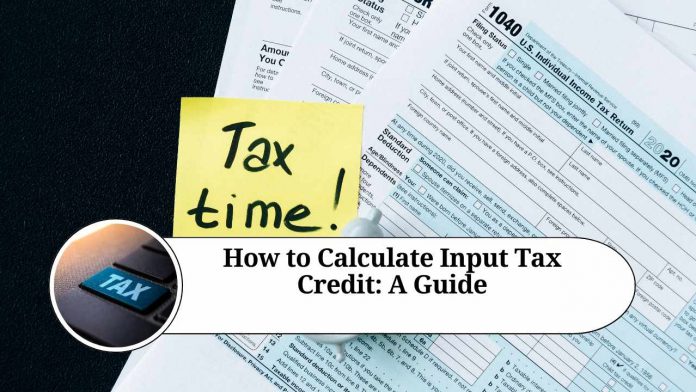Input tax credit (ITC) is a mechanism that allows businesses to offset the taxes they pay on inputs against the tax they collect on outputs. In simpler terms, it is the credit that businesses can claim on the GST paid on purchases against their GST liability on sales. In this blog, we will discuss how to calculate input tax credit and some important things to keep in mind.
Eligibility for Input Tax Credit
To claim input tax credit, a business must be a registered GST taxpayer and the goods or services on which the GST was paid must have been used in the course of business. Additionally, the business must possess a tax invoice or any other prescribed document for the purchase on which the ITC is being claimed.
Calculation of Input Tax Credit
To calculate the input tax credit, you need to follow these steps:
Step 1: Add up the GST paid on purchases made during the tax period.
Step 2: Identify the inputs that are eligible for ITC.
Step 3: Calculate the amount of ITC by multiplying the total eligible GST paid on purchases by the percentage of eligible input.
Step 4: Subtract the ITC from the GST payable on sales made during the tax period.
For example, if a business purchased goods worth $10,000 with a GST of 10%, the total GST paid would be $1,000. If the business sold goods worth $20,000 with a GST of 10%, the GST payable would be $2,000. If the inputs are eligible for 80% ITC, the ITC amount would be $800. Therefore, the business would need to pay only $1,200 in GST, i.e., $2,000 (GST payable) – $800 (ITC).
Important Things to Keep in Mind
a. Timely Filing of GST Returns: It is important to file GST returns on time to claim the input tax credit. If returns are filed late, ITC cannot be claimed for that period.
b. Matching of Invoices: The GST paid on purchases can be claimed as ITC only if it matches the details mentioned in the tax invoice. Therefore, businesses must ensure that the details in their purchase invoices match with the details in the supplier’s invoice.
c. ITC on Capital Goods: ITC can also be claimed on capital goods like machinery, equipment, and furniture. However, the ITC is allowed in installments over a period of time.
In conclusion
input tax credit is an important mechanism for businesses to reduce their GST liability. By following the steps mentioned above and keeping in mind the important points, businesses can accurately calculate their ITC and claim it in a timely manner.
Read more useful content:
- section 145 of income tax act
- section 10e of income tax act
- section 9 of the income tax act
- section 94b of income tax act
- section 206aa of income tax act
Frequently Asked Questions (FAQs)
Q1. What is Input Tax Credit (ITC)?
A1. Input Tax Credit (ITC) is a mechanism that allows businesses to claim a credit for the GST paid on purchases against the GST liability on sales. It helps businesses to reduce their overall tax liability.
Q2. Who is eligible to claim Input Tax Credit?
A2. A registered GST taxpayer who has paid GST on purchases made for the purpose of business is eligible to claim Input Tax Credit.
Q3. How is Input Tax Credit calculated?
A3. To calculate Input Tax Credit, you need to add up the GST paid on purchases made during the tax period, identify the inputs that are eligible for ITC, calculate the amount of ITC by multiplying the total eligible GST paid on purchases by the percentage of eligible input, and subtract the ITC from the GST payable on sales made during the tax period.
Q4. Can Input Tax Credit be claimed on all purchases?
A4. No, Input Tax Credit can be claimed only on purchases that are used for business purposes. Additionally, some goods and services are exempt from GST, and ITC cannot be claimed on those.
Q5. Is it mandatory to claim Input Tax Credit?
A5. No, it is not mandatory to claim Input Tax Credit. However, businesses are encouraged to claim ITC to reduce their overall tax liability.
Q6. Is there any time limit for claiming Input Tax Credit?
A6. Yes, the time limit for claiming Input Tax Credit is the earlier of the following:
The date of filing the GST return for September of the following year
The date of filing the GST return for the month of September following the end of the financial year to which the ITC relates
Q7. What are the important things to keep in mind while calculating Input Tax Credit?
A7. Some important things to keep in mind while calculating Input Tax Credit are timely filing of GST returns, matching of invoices, and claiming ITC only on eligible inputs.
Q8. Can Input Tax Credit be claimed on capital goods?
A8. Yes, Input Tax Credit can be claimed on capital goods like machinery, equipment, and furniture. However, the ITC is allowed in installments over a period of time.
Q9. Can Input Tax Credit be claimed on interstate purchases?
A9. Yes, Input Tax Credit can be claimed on interstate purchases if the GST paid on those purchases is eligible for ITC.
Q10. What happens if Input Tax Credit is claimed wrongly or fraudulently?
A10. If Input Tax Credit is claimed wrongly or fraudulently, it can result in penalties, interest, and legal action. Therefore, businesses should ensure that they claim ITC only on eligible inputs and follow the prescribed procedures.




















